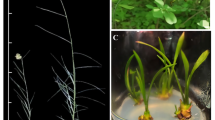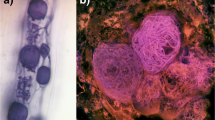Summary
The accumulation of mansonones E and F was investigated in Ulmus americana L. seedlings 5 weeks after inoculation with three aggressive and three non-aggressive isolates of Ophiostoma ulmi (Buism.) Nannf. The three non-aggressive isolates stimulated significantly more mansonone E and F accumulation than the three aggressive isolates of O. ulmi. Mansonone induction also varied within both the aggressive and the non-aggressive groups. Aggressive and non-aggressive isolates were recovered in equal frequencies from the inoculation wounds, whereas the aggressive isolates were recovered more frequently than the non-aggressive isolates 15 cm and 25 cm up the seedlings' stem. Vascular browning in the outer xylem of the seedlings correlated with mansonone E and F accumulation. Mansonone accumulation in U. americana seedlings is therefore associated with vascular browning and a reduction in fungal spread.
Similar content being viewed by others
References
Bonsen KJM, Scheffer RJ, Elgersma DM (1985) Barrier zone formation as a resistance mechanism of elms to Dutch elm disease. IAWA Bull 6: 71–77
Brasier CM (1977) Inheritance of pathogenicity and cultural characters in Ceratocystis ulmi: hybridization of protoperithecial and non-aggressive strains. Trans Br Mycol Soc 68: 45–52
Brasier CM (1979) Dual origin of recent Dutch elm disease outbreaks in Europa. Nature 281: 78–80
Brasier CM (1981) Laboratory investigation of Ceratocystis ulmi. In: Stipes RJ, Campana RJ (eds) Compendium of elm diseases. Am Phytopathol Soc Monogr: 76–79.
Brasier CM (1982) Genetics and pathogenicity of Ceratocystis ulmi and its significance for elm breeding. In: Heybroek HM, Stephan BR, Weissenberg K von (eds) Resistance to disease and pests in forest trees. Pudov, Wageningen, Netherlands, pp 224–235
Brasier CM (1986) The population biology of Dutch elm disease. Adv Plant Pathol 5: 53–118
Brasier CM (1988) Rapid changes in genetic structure of epidemic populations of Ophiostoma ulmi. Nature 332: 538–541
Campana RJ (1978) Inoculation and fungal invasion of the tree. In: Sinclair WA, Campana RJ (eds) Dutch elm disease: perspectives after 60 years. Cornell Univ Agric Exp Stn Search (Agr) 8: 7–20
Duchesne LC (1988) Resistance mechanisms to Dutch elm disease: a review. Can Nat (Ottawa) 115: 163–167
Duchesne LC, Jeng RS, Hubbes M (1985) Accumulation of phytoalexins in Ulmus americana in response to infection by a non-aggressive and an aggressive strain of Ophiostoma ulmi. Can J Bot 63: 678–680
Duchesne LC, Hubbes M, Jeng RS (1986) Mansonone E and F accumulation in Ulmus pumila, resistant to Dutch elm disease. Can J For Res 16: 410–412
Dumas, MT, Strunz GM, Hubbes M, Jeng RS (1986) Inhibition of Ceratocystis ulmi by mansonones A, C, D, E, F, and G isolated from Ulmus americana. Eur J For Pathol 16: 217–222
Elegersma DM, Overeem JC (1971) The relation of mansonones to resistance against Dutch elm disease and their accumulation as induced by several agents. Neth J Plant Pathol 79: 218–220
Gagnon C (1967) Polyphenols and discoloration in the elm disease investigated by histochemical techniques. Can J Bot 45: 2119–2124
Gagnon C (1968) Peroxidase in healthy and diseased elm trees investigated by the benzidinine histochemical technique. Can J Bot 46: 1491–1491
Gagnon C (1969) Technique histochimique pour l'étude de la polyphenoloxidase dans le xylème de L'orme d'amérique. Can Nat (Ottawa) 96: 203–210
Hubbes M, Jeng RS (1981) Aggressiveness of Ceratocystis ulmi strains and resistance in Ulmus americana. Eur J For Pathol 11: 257–254
MacHardy WE (1978) Mechanisms of resistance. In: Sinclair WA, Campana RJ (eds) Dutch elm disease: perspectives after 60 years. Cornell Univ. Agric Exp Stn Search (Agr) 8: 25–27
Pomerleau R (1968) Progression et localisation de l'infection par le Ceratocystis ulmi dans l'orme d'amérique. Phytophatol Z 63: 301–326
Rioux D, Quellette GB (1989) Light microscope observations of histological changes induced by Ophiostoma ulmi in various nonhost trees and shrubs. Can J Bot 67: 2335–2351
Schreiber LR, Townsend AM (1976) Variability of aggressiveness, recovery and cultural characteristics of isolates of Ceratocystis ulmi. Phytopathology 66: 239–244
Shigo AL (1984) Compartmentalization: a conceptual frame work for understanding how trees grow and defend themselves. Annu Rev Phytopathol 22: 189–214
Shigo AL, Tippet JT (1981) Compartmentalization of American elm tissues infected by Ceratocystis ulmi. Plant Dis 65: 715–718
Sinclair WA, Larsen AG (1980) Localization of Dutch elm disease in 10-year-old white elm clones from resistant parents. Plant Dis 64: 203–205
Sinclair WA, Zahand JP, Melching JB (1975) Localization of infection in American elms resistant to Ceratocystis ulmi. Phytopathology 65: 129–133
Sokal RR, Rohlf FJ (1981) Biometry, 2nd edn. Freeman, San Francisco
Takai S (1980) Relationship of the production of the toxin cerato-ulmin, to synnemata formation, pathogenicity, mycelial habit, and growth of Ceratocystis ulmi isolates. Can J Bot 58: 658–662
Wu WD, Jeng RS, Hubbes M (1989) Toxic effects of elm phytoalexin mansonones on Ophiostoma ulmi, the causal agent of Dutch elm disease. Eur J For Pathol 19: 343–357
Yang D, Jeng RS, Hubbes M (1989) Mansonone accumulation in elm callus cultures induced by elicitors of Ophiostoma ulmi, and general properties of elicitors. Can J Bot 67: 3490–3497
Author information
Authors and Affiliations
Rights and permissions
About this article
Cite this article
Duchesne, L.C., Jeng, R.S., Hubbes, M. et al. Accumulation of mansonones E and F in seedlings of Ulmus americana in response to inoculation with Ophiostoma ulmi . Trees 4, 187–190 (1990). https://doi.org/10.1007/BF00225314
Received:
Issue Date:
DOI: https://doi.org/10.1007/BF00225314




